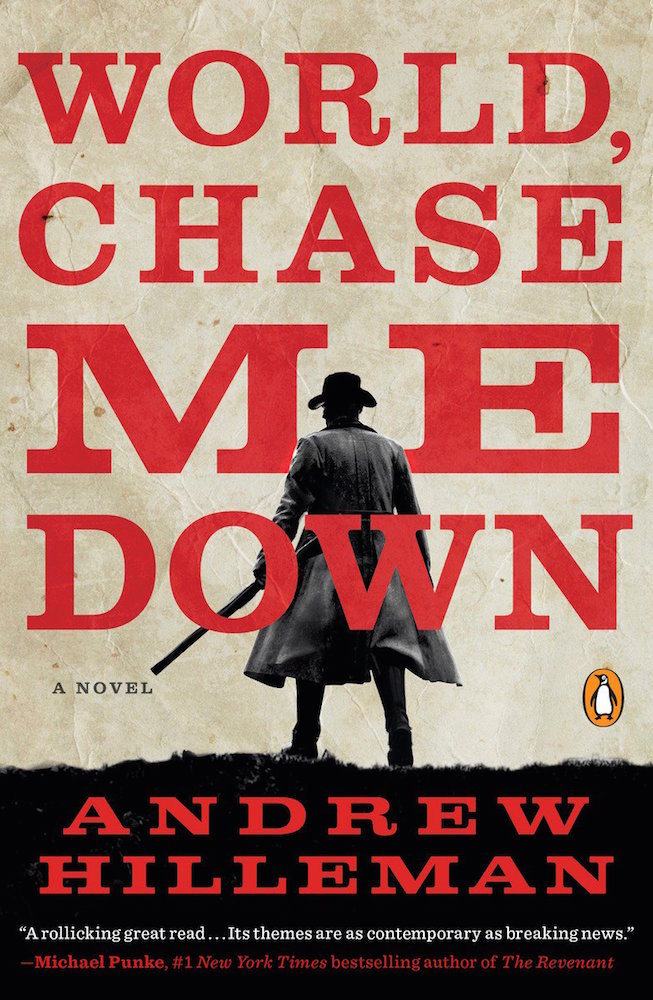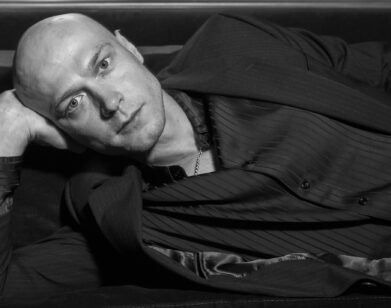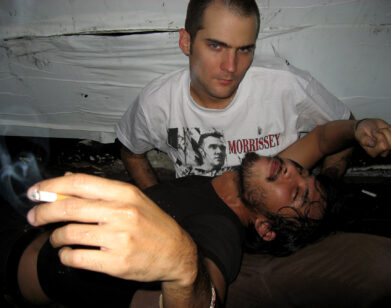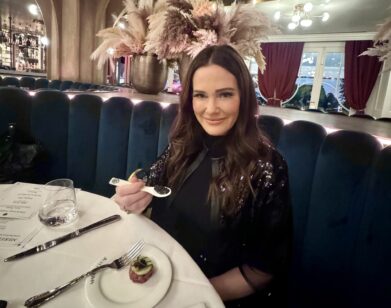The Chase

As outlaw tales go, Andrew Hilleman’s debut novel, World, Chase Me Down (Penguin) ranks alongside the likes of Jesse James, Butch Cassidy, and Billy the Kid. Out this week, the novel centers around the exploits of Pat Crowe, a real historical figure who, after kidnapping of the son of an Omaha meatpacking tycoon in 1900, was regarded as one of America’s most wanted criminals. Violent, funny, and unpredictable with taught, authentic first-person person prose and cinematic scope, World, Chase Me Down is a western that begs to see itself in film.
Like his protagonist, Hilleman, 34, is an Omaha, Nebraska native. He received his MFA from Northern Michigan University.
JEFF VASISHTA: Kind of like Peter Carey did with his Ned Kelly novel, True History Of The Kelly Gang, you paint a very sympathetic picture of someone who committed crime after crime. From your research, was it true to life or did you use artistic license to create a new character?
ANDREW HILLEMAN: A lot of artistic license was used to develop Pat Crowe. I like to think of my portrayal of Pat Crowe as honest, but not factually true. So much of his character is revealed through dialogue—I approached his development with a cinematic lens—and there’s no way to recover some of what he actually said in the personal moments of his life from over a hundred years ago. There’s a great deal of myself inside Pat Crowe as well. Like an actor who takes on a hearty role, I invested a lot of my own emotion and personality into Pat. I was at a time in my life where I keenly empathized, and always will, with many of Pat’s problems.
VASISHTA: Pat Crowe is someone who does a terrible thing, but the reader is so emotionally enrolled in his survival. He always redeems himself. Even when he kicks a man off a stool, he’s wracked with guilt and helps him up again. He kills people along the way, some quite innocent, but the pendulum always seems to swing back to favor him. Not an easy thing to pull off.
HILLEMAN: That’s kind of you to say. Pat is a villainous character that you can’t help but root for because he doesn’t want anything to do with wickedness. Even when he kidnaps Edward Cudahy Jr., he gets no satisfaction from the act. His heart isn’t in it. A truly evil character would take immense pleasure in accomplishing what Pat does, but his criminal success only brings him more pain and sorrow. Even the fact that he later becomes an inspiration to the poor and destitute of the nation gives him little joy, and certainly not redemption. In that way, he’s much more Tom Joad than he is Robin Hood.
VASISHTA: How did you research the dialogue of the day?
HILLEMAN: That was a hodgepodge effort. My research was all over the map to create period-authentic dialogue. More than anything else, I wanted to get the tone of the dialogue right—more than making it 100 percent accurate to the first five years of the 20th century. I watched a ton of old movies, a lot of classic Westerns and gangster flicks, to help create that kind of conversational music in my own head space.
VASISHTA: How long did it take for you to write it? It seems like it must have been meticulously plotted?
HILLEMAN: About two years. But it would’ve been longer had I not already worked on a previous, and failed, novel that takes place in historic Omaha about the city’s political boss, Tom Dennison. I was able to salvage a lot of that manuscript for scraps that helped build World, Chase Me Down. The plot wasn’t nearly as hard to craft as the novel’s structure. The big plot elements already existed in history. The real work came in how to arrange them on the page for a novelistic retelling. Almost all of my revision effort dealt with the narrative blueprint. Originally the novel was much longer. I left nearly 300 pages on the cutting room floor. I approached my revisions with the mindset of a screenwriter to glean the fat: If this story was being made into a movie, what absolutely has to be on the screen?
VASISHTA: Pat’s got an incredible sense of humor. The way he talks about Billy’s STD: “You ain’t got the itches for her. You got them from her.” You must have been chuckling away when you wrote some of this.
HILLEMAN: A lot of the book is quite funny. I’m glad you enjoyed those moments. I love deadpan humor and adore stand-up comedians who can deliver their jokes in that vein. My father is a master of deadpan and some of that rubbed off on me to be certain. But, here’s the thing with the humor in the novel: it all stems from a place of deep agony. The funniest moments in the book are often some of the saddest in the same breath. Pain and jest are born of the same germ. Take the line you mention about Billy’s STD, for example; it’s also a commentary on his loneliness and heartbreak. What follows on the next page is this insight from Pat: “As if just in case the syphilis didn’t stick with him long enough, that damn crazy bastard had it in his head to go off and wed the source. The penance the lonely suffer for their sins is far greater than that of the wicked.”
VASISHTA: It’s a brutal world, but one of the morals of the story seems to be stealing never pays off.
HILLEMAN: I hope it’s not quite that simple. The old clichéd relic I desperately wanted to avoid: crime doesn’t pay. It certainly didn’t for Pat. But it’s more complicated than that. His crime mutated into inspiration for the poorest of the city. It gave them hope: we are not all alone in this mess. There’s a small comfort, even optimism, in knowing your pain is communal rather than solitary. God, if that doesn’t resonate with America today, I don’t know what does.
VASISHTA: Did you make up any of the destinations Pat visited when he was on the run? South Africa was an interesting choice.
HILLEMAN: Most destinations during his five-year long manhunt were places he really visited. He actually joined up with the Boer rebels in South Africa during the Second Boer War. His escape across the Missouri River also really did happen, but many of the details are fabricated. On the other hand, the violence depicted on the Arizona-Mexico border was pure invention. Like all else in the book, his time on the run is a concoction of both creativity and truth.
VASISHTA: Did you find it hard to get agents and publishers interested in a western? How did you get your book deal?
HILLEMAN: Finding an agent was rather easy. “Easy” is probably the wrong word. This is because my agent, Christopher Rhodes, is a godsend. Any writer out there looking for representation should only be so lucky to find an agent as devout and skilled as Christopher. I sent out the manuscript blind—I mean, I was very careful in selecting which agents to contact, but I wanted to be in the slush pile. Most writers hope to avoid the slush pile at all costs and rely on who they know, etcetera. I wanted the exact opposite. I wanted an agent who chose to represent me because of the novel itself, not from a favor owed to another client. Finding a publisher was a little more tricky. Earlier I mentioned that I cut some 300 pages from the novel. Before that, we got about 30 rejections. It was just too damned long. No one was willing to risk publishing a 700-page behemoth from a debut writer. Once I cut it down, we found a publisher pretty quickly. Like Christopher, my editor John Siciliano at Penguin has been nothing short of spectacular. I feel incredibly blessed to have both on my team.
Also, I never pitched the novel as a western. It has western tropes, but there aren’t any silly duels at high noon outside the saloon or rolling tumbleweeds or genre clichés of that nature. I think that will surprise a lot of people once they start reading.
VASISHTA: How is your creative day spent? Are you a morning writer or night writer?
HILLEMAN: I wrote nearly all of World, Chase Me Down late at night. I’d come home from bartending at one or two in the morning and write until sometimes 8 or 8 A.M. It was perfect: no one else was awake, there wasn’t anything else to do, and so I had no distractions. It gave me large chunks of time to create. If I had my druthers, I’d still write at night. But being a father to a toddler doesn’t allow for that practice much anymore. I find time where I can. It’s not optimal, but I make do.
WORLD, CHASE ME DOWN IS OUT NOW.






